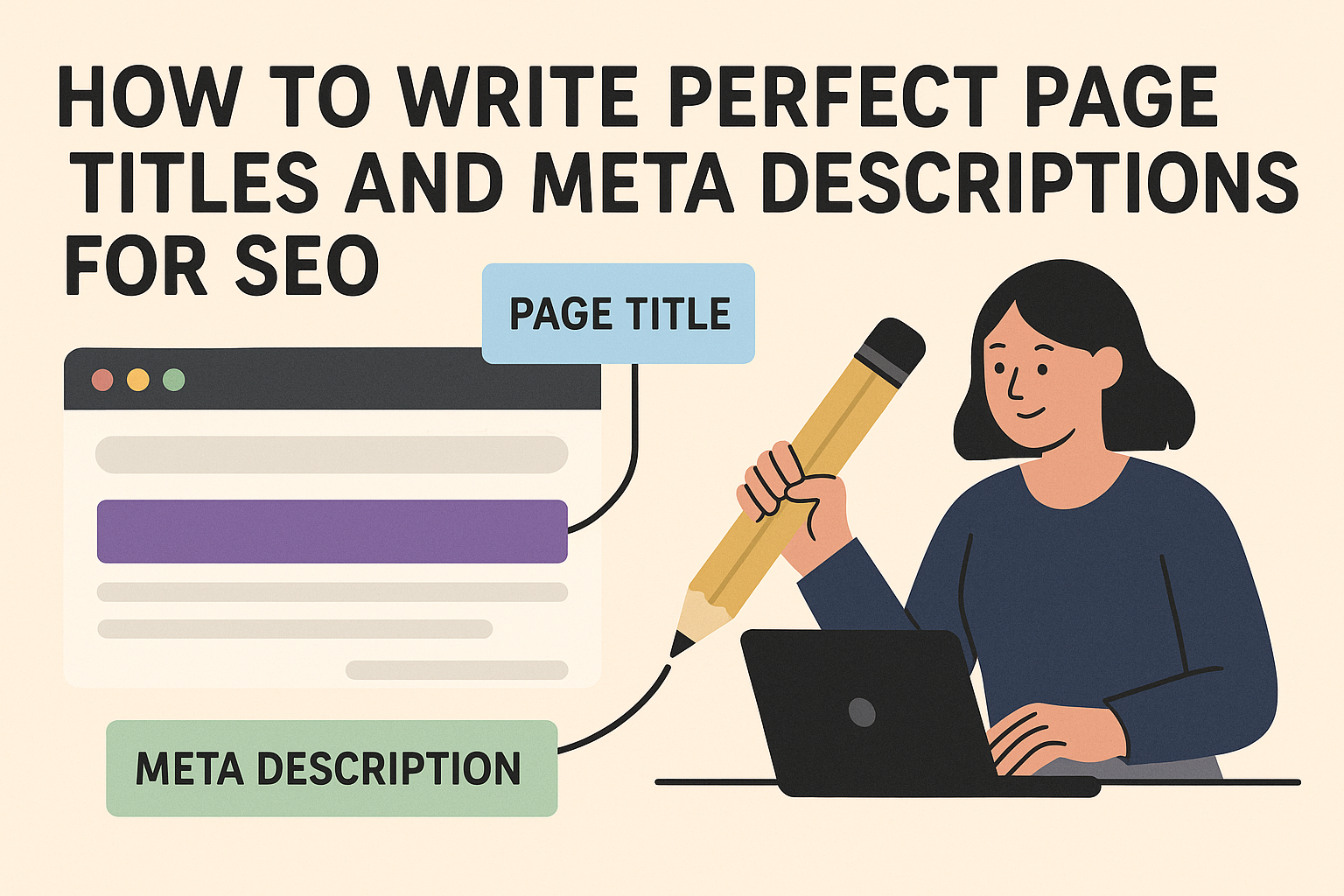 How to Write SEO-Friendly Title and Meta Description Using AI
How to Write SEO-Friendly Title and Meta Description Using AI
In today’s digital landscape, the role of search engine optimization (SEO) has become increasingly important. As content creators, marketers, and business owners, we are constantly striving to improve visibility, click-through rates, and organic traffic from search engines. One crucial yet often overlooked aspect of SEO is crafting effective and SEO-friendly titles and meta descriptions.
With the advent of AI tools, creating optimized content has become easier than ever. AI-driven platforms such as Jasper, Copy.ai, and Surfer SEO offer solutions that streamline the process of writing titles and meta descriptions. In this article, we will walk through how to write SEO-friendly titles and meta descriptions using AI, along with best practices that will help ensure that your content ranks well on search engines.
Why Are SEO-Friendly Titles and Meta Descriptions Important?
Before diving into the technicalities, let’s take a moment to understand the significance of SEO titles and meta descriptions:
SEO Title:
- It is the clickable headline that appears in search engine results pages (SERPs).
- A well-crafted SEO title can significantly impact your page’s click-through rate (CTR).
- It is also a ranking factor for search engines, as it helps search engines understand the content of your page.
Meta Description:
- The meta description is a brief summary of a webpage’s content. While it doesn’t directly affect rankings, it influences the decision-making process of potential visitors.
- A compelling meta description increases the likelihood of users clicking on your link over others.
- Meta descriptions are usually between 150-160 characters, so it’s crucial to make every word count.
By crafting SEO-friendly titles and meta descriptions, you are not only ensuring that your content is optimized for search engines but also increasing its likelihood of being clicked on by users.
Step-by-Step Guide to Writing SEO-Friendly Titles Using AI
Step 1: Understand the Basics of SEO Titles
An SEO title should be:
- Keyword-Rich: Including your target keyword at the beginning of the title helps search engines understand what the page is about.
- Concise and Clear: A good SEO title should be clear, concise, and to the point. Aim for 50-60 characters to prevent it from getting cut off in search results.
- Engaging: Your title should encourage clicks by being engaging and relevant to the user’s query.
- Unique: Each page on your site should have a unique title that accurately represents its content.
Step 2: Choose Your Target Keyword
To generate an SEO-friendly title using AI, you first need to determine the keyword you want to target. This could be a product, service, or a specific topic. You can use keyword research tools like Google Keyword Planner, Ahrefs, or SEMrush to identify high-volume keywords related to your topic.
For example, if you are writing about SEO practices, your target keyword might be “SEO tips.”
Step 3: Input Information into AI Tools
AI tools such as Jasper, Copy.ai, or Writesonic allow you to input the following details:
- Topic or Keyword: The primary subject matter you are focusing on.
- Search Intent: Whether the goal of the page is informational, navigational, transactional, or commercial.
- Target Audience: Who is your content aimed at? (e.g., beginners, experts, businesses)
Once you have entered this information, the AI tool will generate a range of title options. You can then choose the one that best fits your content.
Step 4: Refine and Optimize the Title
While AI can generate many title options, it’s important to review them and refine them as necessary. Here are some things to keep in mind:
- Keyword Placement: Ensure the keyword is placed as early as possible in the title.
- Add a Hook: A good title should intrigue the reader. Use action verbs or phrases like “ultimate guide,” “step-by-step,” “top tips,” etc.
- Check Length: Make sure the title is between 50-60 characters to avoid it being cut off in search results.
Example AI Prompt for Title Generation:
“Generate a compelling SEO title for a blog post about ‘SEO Tips for Beginners in 2025’.”
The AI will produce options like:
- “SEO Tips for Beginners in 2025: A Complete Guide”
- “2025 SEO Tips for Beginners: Master Search Engine Rankings”
- “SEO Tips for Newbies: Get Started in 2025”
These titles are clear, concise, and contain the target keyword “SEO tips.”
Step-by-Step Guide to Writing SEO-Friendly Meta Descriptions Using AI
Step 1: Understand the Importance of Meta Descriptions
Meta descriptions, although not a direct ranking factor, play a critical role in:
- Encouraging Click-Throughs: A well-written meta description can compel users to click on your link when they see it in search results.
- Summarizing Content: It provides a concise preview of what the content is about.
An effective meta description should:
- Be between 150-160 characters.
- Contain the target keyword or related variations.
- Include a call to action (CTA) to encourage clicks.
- Be informative and relevant to the content.
Step 2: Summarize the Content of the Page
Before generating the meta description, briefly summarize the content of your page. Think about:
- What the page is about.
- What problem does it solve for the user?
- What value does it provide?
Step 3: Input Information into AI Tools
AI tools can help generate meta descriptions that summarize your content in a concise and engaging way. Just like with titles, you’ll need to provide information like:
- Content Overview: A brief description of what the content is about.
- Target Keyword: The main keyword that you want to rank for.
- Call to Action: Something like “Learn more,” “Read now,” or “Discover the secrets.”
Example AI Prompt for Meta Description Generation:
“Generate an SEO-friendly meta description for a blog post on ‘SEO Tips for Beginners in 2025’ with a CTA and the keyword ‘SEO tips’.”
The AI may produce:
- “Discover the best SEO tips for beginners in 2025. Learn proven strategies to improve your search engine rankings today!”
- “Looking for SEO tips to boost your rankings? Check out our expert guide for beginners in 2025!”
These meta descriptions are clear, concise, and include a CTA to entice clicks.
Step 4: Refine the Meta Description
Just like with titles, refine the AI-generated meta description:
- Include the Keyword: Ensure the keyword appears naturally within the description.
- Add a CTA: Encourage users to click by adding phrases like “Read more,” “Learn how,” or “Get started.”
- Make It Compelling: Ensure that the description matches the value of the content and entices users to click.
AI Tools for Title and Meta Description Generation
Here are some popular AI tools you can use to generate SEO-friendly titles and meta descriptions:
- Jasper (formerly Jarvis): Jasper is one of the most popular AI tools for content generation, offering a dedicated “SEO Mode” that helps create optimized titles, meta descriptions, and more.
- Copy.ai: Copy.ai offers AI-powered templates to generate SEO-optimized titles and descriptions in seconds.
- Writesonic: Similar to Jasper, Writesonic provides easy-to-use features for generating SEO-friendly titles and meta descriptions.
- Surfer SEO: Surfer SEO not only helps generate SEO content but also offers optimization suggestions based on keyword usage, keyword density, and competition.
These tools use AI models trained on SEO principles, so they understand how to craft titles and descriptions that are both human-readable and search engine-friendly.
Best Practices for Writing SEO Titles and Meta Descriptions
While AI can certainly help you generate optimized content, you still need to follow some best practices to ensure the best results:
- Don’t Overstuff Keywords: Keyword stuffing can harm your rankings. Use natural language that’s easy to read.
- Craft Titles for Humans, Not Just Search Engines: Ensure your title appeals to the reader’s curiosity or interest. It’s not just about ranking; it’s about click-through rates.
- Consistency Across Pages: Ensure each page on your site has a unique title and meta description. Avoid duplicating meta descriptions across different pages.
- Test and Optimize: Use A/B testing to find the most effective titles and descriptions. Google Search Console can help track your click-through rates (CTR), which can give you insight into how well your titles and descriptions are performing.
Conclusion
Writing SEO-friendly titles and meta descriptions is an essential aspect of optimizing your content for both search engines and users. With the help of AI tools like Jasper, Copy.ai, and Surfer SEO, you can streamline the process and generate optimized content quickly.
By focusing on keyword placement, crafting engaging and compelling titles, and ensuring your meta descriptions summarize the content with a clear call to action, you can significantly improve your content’s visibility and click-through rates. Remember to always refine and optimize AI-generated content, and follow SEO best practices to stay ahead of the competition.
AI is a powerful tool, but it’s your understanding of SEO principles and your ability to adapt them to your content that will ultimately drive results.

